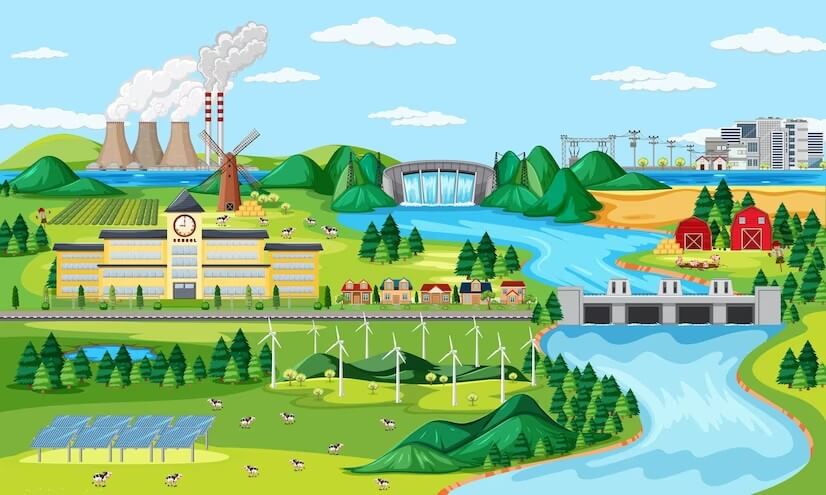Updated March 14, 2023
What is Geothermal Energy?
Geothermal Energy originates from celestial bodies’ formation and various minerals’ radioactive decay, generating heat within the earth’s crust. The term “Geo” in Greek means “earth,” while “thermal” means “heat.” Humans can utilize this renewable resource with their ease. Hot rocks from the earth’s core release heat, creating tremendous moisture and steam from the earth’s surface. They collect this steam and use it to generate electricity. In this article, you will get to know about the different advantages and disadvantages of geothermal energy.
Top 6 Advantages of Geothermal Energy
The below section lists the top 6 advantages of geothermal energy:
#1 Renewable Energy
People can draw geothermal energy from the planet’s interior, and this renewable resource will remain readily accessible as long as the world survives. Thus, it is a renewable form of energy that can be utilized for about 4-5 billion years. Even if fossil fuels get exhausted, people will benefit from geothermal power.
#2 Environment Friendly
Geothermal energy is environmentally friendly and has the lowest environmental effect of any power source. Geothermal electricity is almost emission-free during the development and manufacturing processes.
When generating this form of power, it doesn’t consume any carbon. Moreover, the entire technique can clear up sulphur that might have been emitted from other procedures.
#3 Requires No Fuel
Despite its reputation as an alternative energy source that is environmentally friendly, geothermal energy sadly also causes a few minor environmental problems. When geothermal energy is extracted from the earth, greenhouse gases such as carbon dioxide, methane, and ammonia are released. However, the amount of gas emitted is far less than it would be with fossil fuels.
#4 Abundant Supply of Energy
No power shortages or other issues with geothermal energy can arise with different kinds of electricity. This energy is not affected by similar difficulties as wind or solar, so there will be no energy scarcity due to weather conditions. Thus, there is nearly an infinite supply of energy, and hence there will be no energy shortage.
#5 Zero Noise Pollution
The noise levels produced by geothermal power facilities are low and undetectable, even when they are operating at total capacity. The noise is only made when the plants are being built and when the excavation is carried out.
#6 Lowest Land Footprint Zero Noise Pollution
Geothermal energy pulls heat from the steam produced by the hot water. The smoke produced by the hot water drives the turbines that generate power. A large quantity of underground plumbing is required to obtain this energy. Nonetheless, because of technological advancements, energy requires the lowest land footprint
Top 5 Disadvantages of Geothermal Energy
As discussed, there are both advantages and disadvantages of geothermal energy. Here are some of the drawbacks.
#1 Geographic Distraction
The biggest drawback of geothermal energy is that it is peculiar to its location. The geothermal plants must be constructed where power is available; hence, the point is restricted to specific regions. Furthermore, the sites are away from urban areas and could be more helpful to the cities.
#2 High Prices
Utilizing geothermal energy is expensive. Moreover, the price of a plant with a 1-megawatt capacity is between $2 and $7 million. The initial investment can take a lot of time to recover the money.
#3 Concerns about Greenhouse Emissions in the Environment
Despite its reputation as an alternative energy source that is environmentally friendly, geothermal energy sadly also causes a few minor environmental problems. When extracting geothermal energy from the earth, it releases greenhouse gases such as carbon dioxide, methane, and ammonia. However, the amount of gas emitted is far less than what fossil fuels would release.
#4 The Sweltering Temperatures
The process of extraction takes a lot of work to carry out. Moreover, before extracting energy, it is essential to dig deep inside the earth. Which is quite difficult. For geothermal activities to commence, the location should have a temperature of at least 350 degrees Fahrenheit; otherwise, the processes may not proceed as desired. This problem of high-temperature circumstances adds to the drawbacks of geothermal energy.
#5 Geothermal installations are susceptible to exhaustion
Even after years of operation, geothermal energy from the reservoir can fade away. Though this process takes decades, it’s essential to use the heat wisely and not misuse it. Inappropriate usage leads to inefficient heat dispersion.
Conclusion
After knowing about the advantages and disadvantages of geothermal energy, you can conclude that this energy source is more ecologically benign than traditional fuels. The biggest drawback of geothermal energy is that it is location-specific. But still, it is one of our most significant assets as an energy resource because of its easy availability.
Recommended Articles
We hope that this EDUCBA information on “Advantages and Disadvantages of Geothermal Energy” was beneficial to you. You can view EDUCBA’s recommended articles for more information,

